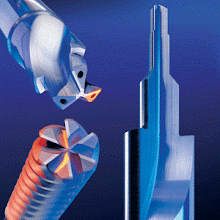Why is it that cutting tools can remove metal?
What does cutting mean ? Let's take a couple of simple examples. Imagine peeling an appleor when using 3 plane in carpentry. When you peel an apple or plane a piece of wood into a particular shape by cutting or shaving, skins are removed and chips are developed. Basically machining and/or cutting is an operation where (an object is machined into a particular shape using a sharp edged blade) When machining takes place the object being machined (from now on the workpiece) and sharp edge blade (from now on the cutting edge) are subjected to severe impact and rubbing at the point of contact. To make machining possible it is essential that the cutting edge. is harder than workpiece material. Using the above examples. a fruit knife is harder than the apple and the blade of a plane is much harder than the piece of wood thus ensuring that cutting can take place. The same goes for when machining metallic objects. The cutting edge needs to be harder than the workpiece machined. Generally, it is said that a cutting tool needs to be at least 3 times harder than the workpiece material.
What actually happens at the cutting edge when machining?
At the point of contact the workpiece and the cutting edge impact with one another and as a result the metal is removed. The metal strips removed from the workpiece by the cutting edge are called "chips" or "swarf?". When machining metals, the cutting edge is subjected to severe impact and extremely high temperatures. As the workpiece and cutting edge impact and rub with each other, the faster this occurs then the higher the cutting edge temperature rises. Generally the cutting edge can reach up to and around 800'C. Cutting tools need to be able withstand the impact and temperatures encountered when machining without sacrificing hardness. Materials that have been widely used are "high-speed steels" and cemented carbides.However in this day and age the cemented carbides are the mainstream





0 comments:
Post a Comment